|
Show all abstracts Show selected abstracts Add to my list |
|
| EDITORIAL |
|
|
|
Molecular aberration studies in cases of idiopathic mental retardation: An update |
p. 123 |
Dhanjit Kumar Das
DOI:10.4103/0971-6866.116100 PMID:24019609 |
| [HTML Full text] [PDF] [Mobile Full text] [EPub] [PubMed] [Sword Plugin for Repository]Beta |
|
|
|
|
|
|
| REVIEW ARTICLE |
 |
|
|
|
Birth defects in India: Hidden truth, need for urgent attention |
p. 125 |
Rinku Sharma
DOI:10.4103/0971-6866.116101 PMID:24019610Birth defects (structural, functional and metabolic disorder present from birth, may be diagnosed later) rising up as an important cause of infant mortality even in developing countries where infant mortality has been reduced to much extent. Seventy percent of birth defects are preventable through the application of various cost effective community genetic services.
Indian people are living in the midst of risk factors for birth defects, e.g., universality of marriage, high fertility, large number of unplanned pregnancies, poor coverage of antenatal care, poor maternal nutritional status, high consanguineous marriages rate, and high carrier rate for hemoglobinopathies. India being the second most populous country with a large number infant born annually with birth defects should focus its attention on strategies for control of birth defects. Many population based strategies such as iodization, double fortification of salt, flour fortification with multivitamins, folic acid supplementation, periconceptional care, carrier screening and prenatal screening are some of proven strategies for control of birth defects. Strategies such as iodization of salt in spite of being initiated for a long time in the past do have a very little impact on its consumption (only 50% were using iodized salt). Community genetic services for control of birth defects can be easily flourished and integrated with primary health care in India because of its well established infrastructure and personnel in the field of maternal and child health care. As there is wide variation for infant mortality rate (IMR) in different states in India, so there is a need of deferential approach to implement community genetic services in states those had already achieved national goal of IMR. On the other hand, states those have not achieved the national goal on IMR priority should be given to management of other causes of infant mortality. |
| [ABSTRACT] [HTML Full text] [PDF] [Mobile Full text] [EPub] [Citations (1) ] [PubMed] [Sword Plugin for Repository]Beta |
|
|
|
|
|
|
| ORIGINAL ARTICLES |
 |
|
|
|
Children with isolated growth hormone deficiency: Empty sella versus normal sella |
p. 130 |
Nagwa Abdallah Ismail, Nermeen Salah Eldin Metwaly, Fatma Ahmed El-Moguy, Mona Hassan Hafez, Soha M. Abd El Dayem, Tarek Mohamed Farid
DOI:10.4103/0971-6866.116102 PMID:24019611Background: Empty sella (ES) may be associated with variable clinical conditions ranging from the occasional discovery of a clinically asymptomatic pouch within the sella turcica to severe intracranial hypertension and rhinorrhea. The need for replacement hormone therapy in ES, as in other syndromes that may cause hypopituitarism, must be assessed for every single hormone, including growth hormone (GH).
Aim: To determine whether or not the presence of ES could allow some changes in the GH responses of the isolated growth hormone deficiency (GHD) patients.
Materials and Methods: We included a cohort of 59 short stature children and adolescents with isolated GHD. According to computed tomography finding, they were classified into 2 groups: Group 1 included 40 children with normal sella and 19 children with ES in Group 2. All patients received recombinant human growth hormone (rhGH) with a standard dose of 20 IU/m 2 /week.
Results: The baseline results were not significantly different for all variables except weight standard deviation was smaller with statistical significant difference ( P = 0.02). We identified no significant differences when comparing both groups, except for height standard deviation (HTSD) after the first year of therapy which revealed significant difference in favor of group 1. When comparing pre- and the two post-treatments HTSD results of the studied cases, all showed significant changes after GH therapy. The results of related variables pre-and post-treatment in both the groups showed significant improvement in all variables of the two groups of the study .
Conclusion: Our study showed a similar stature outcome in the two treatment groups. |
| [ABSTRACT] [HTML Full text] [PDF] [Mobile Full text] [EPub] [PubMed] [Sword Plugin for Repository]Beta |
|
|
|
|
|
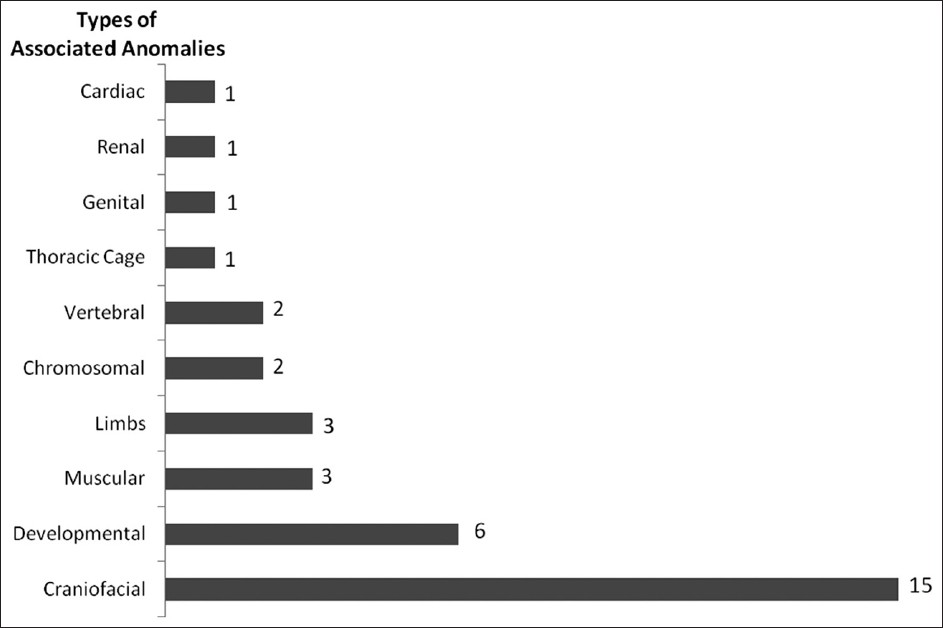  |
Etiology and genetic factors in clefts of lip and/or palate reported at children's hospital, Lahore, Pakistan |
p. 136 |
Muhammad Yaqoob, Farrukh Mahmood, Ghazala Hanif, Saima Mansoor Bugvi, Muhammad Afzal Sheikh
DOI:10.4103/0971-6866.116103 PMID:24019612The etiology of cleft lip (CL) and/or cleft palate (CP) has been extensively studied in industrialized countries and is suggested to be heterogeneous with increasing evidence that both genetic and environmental factors are operating. To evaluate this assertion in a developing country like Pakistan, a case finding cross-sectional study was completed from 1 st July 2010 to 31 st May 2011 for 100 cases of CL and/or CP referred to the Genetic Clinic of the Children's Hospital, Lahore, Pakistan. A clinical examination followed by necessary diagnostic work-up was completed for each case. The cause of CL and/or CP was clear in 18% of the children ( n = 18). Environmental causes were found in 6 children (four mothers developed hyperthermia during the 2 nd month of gestation, one mother was diabetic, and one mother was a known case of epilepsy and took sodium valproate throughout her pregnancy). Six children were suffering from known genetic malformation syndromes (each with Jarcho-Levin syndrome, Oral-Facial-Digital syndrome type XI, Oral-Duplication syndrome, Kabuki syndrome, Fronto-nasal dysplasia and Nager syndrome). Novel chromosomal aberrations were identified in 2 children. In 82% of the children ( n = 82) the cause of oro-facial clefts remained unknown. Impact of gender and consanguinity on the development of CL and/or CP was also studied. Prevalence of CP was significantly more among female children as compared to that in males ( P < 0.05). Associated anomalies were present in 18% of the cases, anomalies of the craniofacial region being the most common. These findings were compared with regional and international studies. |
| [ABSTRACT] [HTML Full text] [PDF] [Mobile Full text] [EPub] [Citations (1) ] [PubMed] [Sword Plugin for Repository]Beta |
|
|
|
|
|
|
Analysis of cytotoxic T-lymphocyte-associated antigen-4 and MMP-9 genes' methylation and their expression profiles with risk of non-alcoholic fatty liver disease |
p. 144 |
Dor Mohammad Kordi Tamandani, Mohammad Hashemi, Sara Shafiepour
DOI:10.4103/0971-6866.116106 PMID:24019613Objective: To investigate the effect of promoter methylation of cytotoxic T-lymphocyte-associated antigen-4 (CTLA-4) gene and matrix metalloproteinases (MMPs) on the risk of non-alcoholic fatty liver disease (NAFLD).
Materials and Methods: CTLA-4 and MMP-9 promoter methylation were investigated using a methylation-specific polymerase chain reaction (MS-PCR) in blood samples taken from 80 NAFLD individuals and 95 healthy controls. The expression levels of CTLA-4 and MMP-9 were also assessed in 10 blood and 9 liver tissues mRNA samples from NAFLD patients. These cases were compared to the blood ( n = 10) samples of healthy controls with real-time quantitative reverse transcriptase PCR.
Results: No significant relationship was found for methylation of CTLA-4 and MMP-9 between cases and controls. The relative expression of CTLA-4 and MMP-9 mRNA in NAFLD was not significantly different compared to healthy control samples.
Conclusion: For the first time, our outcomes indicate that the methylation status of CTLA-4 and MMP-9 genes has no significant function on the process of NAFLD. |
| [ABSTRACT] [HTML Full text] [PDF] [Mobile Full text] [EPub] [Citations (1) ] [PubMed] [Sword Plugin for Repository]Beta |
|
|
|
|
|
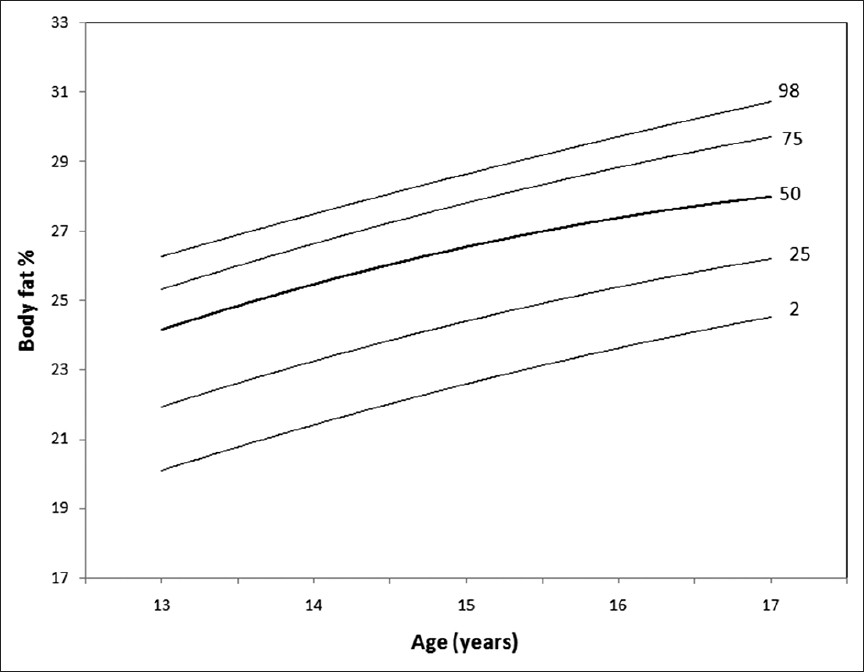  |
Body composition in Egyptian Turner syndrome girls |
p. 150 |
Moushira Erfan Zaki, Hanan H Afifi
DOI:10.4103/0971-6866.116108 PMID:24019614Objective: This cross-sectional study was undertaken to construct the new body fat % curve and provide body composition reference data for adolescent girls with Turner syndrome (TS). They diagnosed cytogenetically by blood karyotyping and not treated with growth hormone (GH).
Materials and Methods: The study included 70 TS girls from age 13 years to age 17 years. Body composition was measured by bioelectrical impedance. Smoothed centile charts were derived by using the least mean square (LMS) method.
Results: The new body fat curves reflect the increase of body fat mass (FM) from age 13 years to age 17 years. Body FM % of Egyptian TS girls was lower when compared with age-matched American untreated TS girls.
Conclusion: This study presents the new body fat curves and reference values of body composition for untreated Egyptian TS adolescent girls. The present charts can be used for direct assessment of body FM % for Egyptian TS girls and evaluation for cases on GH treatment or other growth promoting therapy. |
| [ABSTRACT] [HTML Full text] [PDF] [Mobile Full text] [EPub] [PubMed] [Sword Plugin for Repository]Beta |
|
|
|
|
|
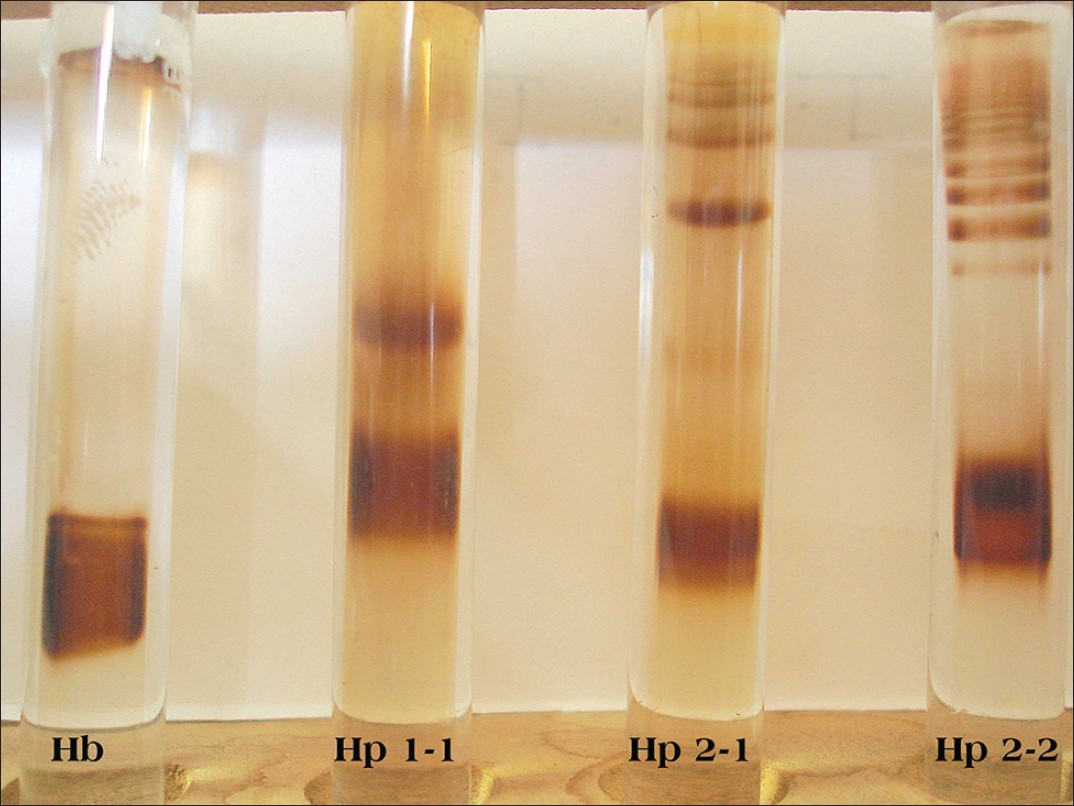  |
Haptoglobin2-2 phenotype is an additional risk factor of retinopathy in type 2 diabetes mellitus |
p. 154 |
Mukund R Mogarekar, Mahesh H Hampe
DOI:10.4103/0971-6866.116111 PMID:24019615Aims: The aim of this study was to investigate the association between haptoglobin (Hp) phenotypes and risk of the development of diabetic retinopathy (DR) in patients of type 2 diabetes mellitus.
Materials and Methods: This cross-sectional study included 45 normotensive type 2 diabetic patients (duration more than 5 years) admitted in the hospital divided into two groups (with and without DR) on the basis of fundus examination by direct ophthalmoscopy. Serum samples of all patients were subjected for Hp phenotyping by polyacrylamide gel electrophoresis.
Results: DR was associated significantly in diabetic patients with Hp2-2 phenotype (79.31%) than diabetic patients with Hp2-1 phenotype (43.75%) and Hp2-2 had higher odds ratio (OR) for DR in univariate analysis (OR 4.929, [95% confidence interval [CI] (1.297-18.733)], P = 0.016) and multivariate analysis (OR 7.704 [95% CI (0.887-66.945)], P = 0.064). Furthermore, Hp2-2 was associated significantly with severe forms of DR.
Conclusion: Hp2-2 phenotype is associated with susceptibility to DR showing a graded risk relationship to the number of Hp2 alleles. Determination of Hp phenotype may be useful in the risk assessment and management of DR. |
| [ABSTRACT] [HTML Full text] [PDF] [Mobile Full text] [EPub] [Citations (1) ] [PubMed] [Sword Plugin for Repository]Beta |
|
|
|
|
|
|
Measuring opportunity for natural selection: Adaptation among two linguistically cognate tribes inhabiting two eco-situations of North-East India |
p. 159 |
Maitreyee Sarma
DOI:10.4103/0971-6866.116113 PMID:24019616Background: Numerous literature on the migration of Mishings point out to the fact that the Mishing and the Minyong are two culturally and linguistically cognate tribes that co-existed in the same ecology in the hills of Arunachal Pradesh. The Mishing tribe after migration, now inhabits flood-prone areas of Brahmaputra valley of Assam.
Aim: The study aims to measure the adaptation process of these two cognate tribes inhabiting two different ecologies at present: Hills and plains by calculating the index of selection intensity by Crow's and Johnston and Kensinger's formulae.
Materials and Methods: The reproductive histories of 77 Mishing mothers of completed fertility inhabiting a flood affected village of Assam and 74 Minyong mothers inhabiting a hilly village of Arunachal Pradesh are selected.
Results and Discussion: The Minyongs show higher average fertility than the Mishings. The proportion of embryonic death is higher, and child death is lower among the Mishings (0.1661; 0.1623) than the Minyongs (0.1319; 0.2238). The index of selection due to mortality component is contributing more toward the total index of selection in both the tribes.
Conclusion: The contribution of mortality component is sizeable to the total selection like many other tribes of North-East India. Higher proportion of embryonic deaths among the Mishings infers that the causes are mostly biological whereas, the higher proportion of child deaths among the Minyongs infers that the causes are mostly socio-cultural. |
| [ABSTRACT] [HTML Full text] [PDF] [Mobile Full text] [EPub] [PubMed] [Sword Plugin for Repository]Beta |
|
|
|
|
|
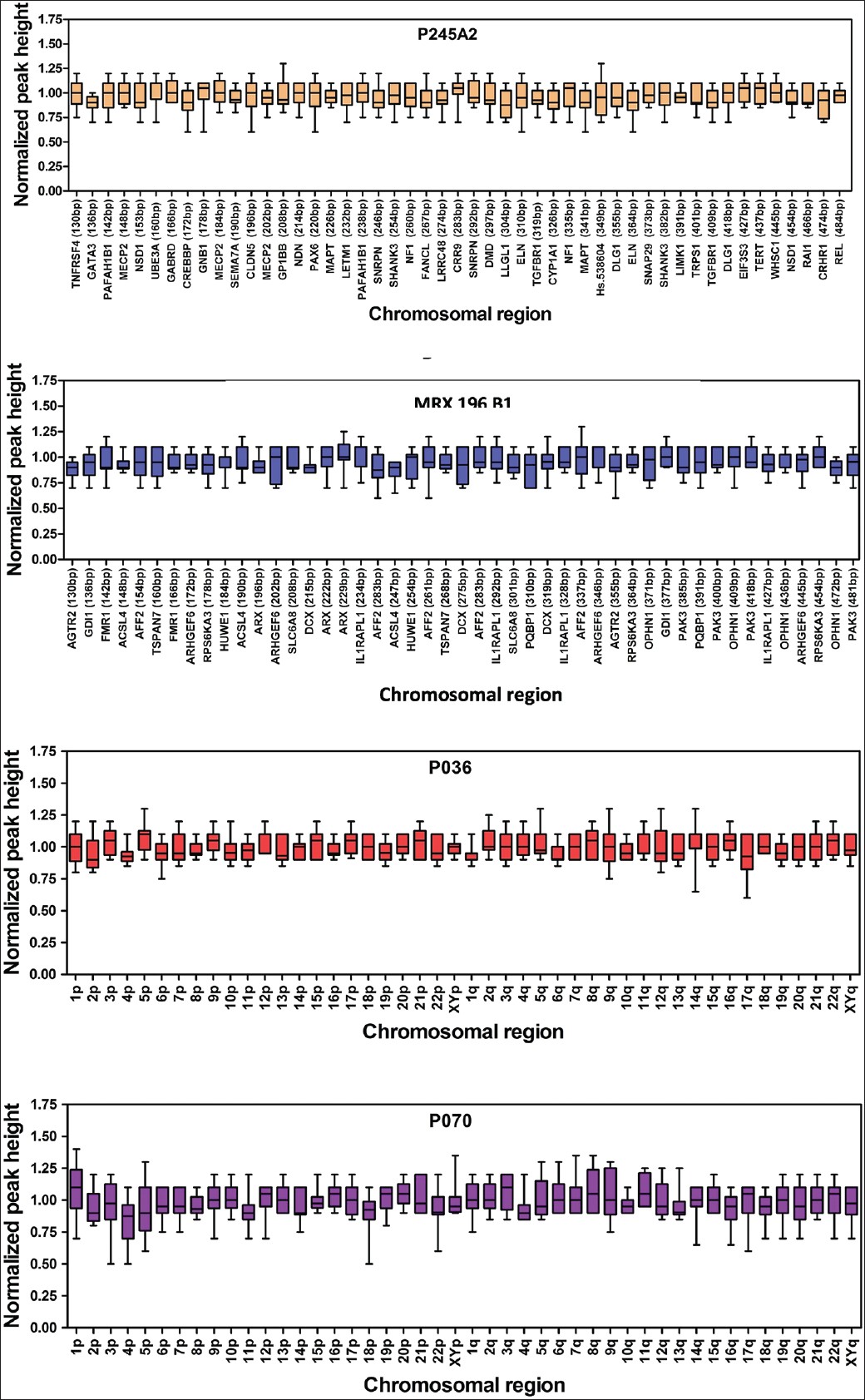  |
Multiplex ligation-dependant probe amplification study of children with idiopathic mental retardation in South India |
p. 165 |
Neetha John, Moka Rajasekhar, Katta Mohan Girisha, Podila Satya Venkata Narasimha Sharma, Puthiya Mundyat Gopinath
DOI:10.4103/0971-6866.116115 PMID:24019617Background: Mental retardation (MR) is a heterogeneous dysfunction of the central nervous system exhibiting complex phenotypes and has an estimated prevalence of 1-3% in the general population. However, in about 50% of the children diagnosed with any form of intellectual disability or developmental delay the cause goes undetected contributing to idiopathic intellectual disability.
Materials and Methods: A total of 122 children with developmental delay/MR were studied to identify the microscopic and submicroscopic chromosome rearrangements by using the conventional cytogenetics and multiplex ligation dependent probe amplification (MLPA) analysis using SALSA MLPA kits from Microbiology Research Centre Holland [MRC] Holland.
Results: All the recruited children were selected for this study, after thorough clinical assessment and metaphases prepared were analyzed by using automated karyotyping system. None was found to have chromosomal abnormality; MLPA analysis was carried out in all subjects and identified in 11 (9%) patients.
Conclusion: Karyotype analysis in combination with MLPA assays for submicroscopic micro-deletions may be recommended for children with idiopathic MR. |
| [ABSTRACT] [HTML Full text] [PDF] [Mobile Full text] [EPub] [PubMed] [Sword Plugin for Repository]Beta |
|
|
|
|
|
|
Subtelomeric chromosomal rearrangements in a large cohort of unexplained intellectually disabled individuals in Indonesia: A clinical and molecular study |
p. 171 |
Farmaditya E. P. Mundhofir, Willy M Nillesen, Bregje W. M. Van Bon, Dominique Smeets, Rolph Pfundt, Gaby van de Ven-Schobers, Martina Ruiterkamp-Versteeg, Tri I Winarni, Ben C. J. Hamel, Helger G Yntema, Sultana M. H. Faradz
PMID:24019618Context: Unbalanced subtelomeric chromosomal rearrangements are often associated with intellectual disability (ID) and malformation syndromes. The prevalence of such rearrangements has been reported to be 5-9% in ID populations.
Aims: To study the prevalence of subtelomeric rearrangements in the Indonesian ID population.
Materials and Methods: We tested 436 subjects with unexplained ID using multiplex ligation dependent probe amplification (MLPA) using the specific designed sets of probes to detect human subtelomeric chromosomal imbalances (SALSA P070 and P036D). If necessary, abnormal findings were confirmed by other MLPA probe kits, fluorescent in situ hybridization or Single Nucleotide Polymorphism array.
Results: A subtelomeric aberration was identified in 3.7% of patients (16/436). Details on subtelomeric aberrations and confirmation analyses are discussed.
Conclusion: This is the first study describing the presence of subtelomeric rearrangements in individuals with ID in Indonesia. Furthermore, it shows that also in Indonesia such abnormalities are a prime cause of ID and that in developing countries with limited diagnostic services such as Indonesia, it is important and feasible to uncover the genetic etiology in a significant number of cases with ID. |
| [ABSTRACT] [HTML Full text] [PDF] [Mobile Full text] [EPub] [PubMed] [Sword Plugin for Repository]Beta |
|
|
|
|
|
|
Small ubiquitin-like modifier 4 M55V polymorphism is not associated with diabetic nephropathy in Iranian type 2 diabetes patients |
p. 179 |
Farhad Shahsavar, Mehrzad Jafarzadeh, Alireza Azargoon, Mehdi Hedayati, Behnam Asadifar
DOI:10.4103/0971-6866.116121 PMID:24019619 |
| [HTML Full text] [Mobile Full text] [EPub] [PubMed] [Sword Plugin for Repository]Beta |
|
|
|
|
|
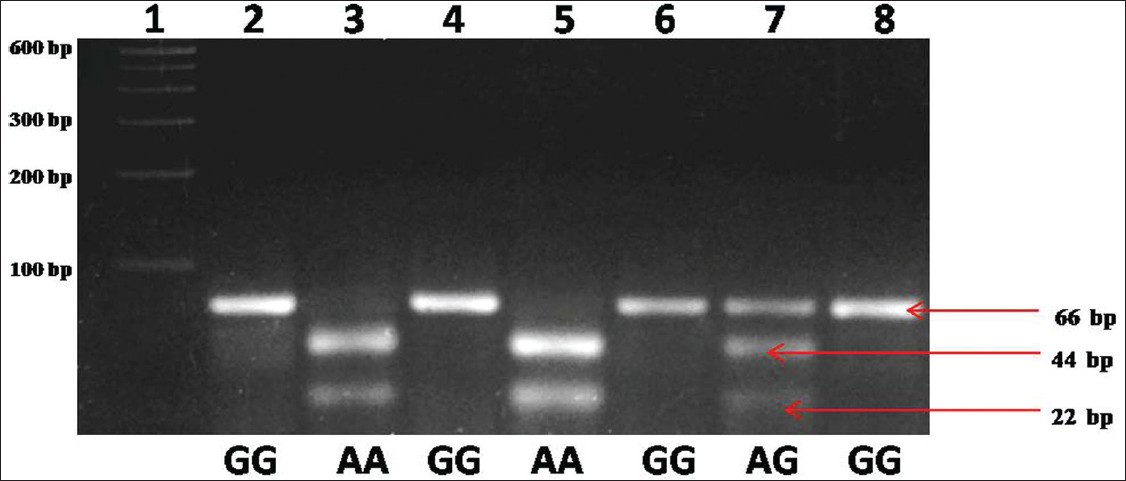  |
Analysis of methionine synthase reductase polymorphism (A66G) in Indian Muslim population |
p. 183 |
Vandana Rai, Upendra Yadav, Pradeep Kumar, Sushil Kumar Yadav
DOI:10.4103/0971-6866.116123 PMID:24019620Background and Objectives: Methionine synthase reductase (MTRR) is a vital enzyme of homocysteine/methionine metabolic pathway and is required for the conversion of inactive form of methionine synthase (MTR) to its active form. A clinically important allelic variant of MTRR A66G, with less enzymatic activity is reported with worldwide prevalence rate of ~ 30%. The present study was designed to determine the frequency of MTRR A66G polymorphism in rural Sunni Muslim population of Eastern Uttar Pradesh.
Materials and Methods: Total 56 subjects were analyzed for MTRR A66G polymorphism. A66G mutation analysis was carried out according to the polymerase chain reaction-restriction fragment length polymorphism method of Wilson et al. [1] amplification with MTRR specific primers followed by amplicon digestion with NdeI enzyme was used for the identification of different MTRR genotypes in subjects.
Results and Discussion: The AA genotype was found in 5 subjects, AG in 23 subjects, and GG genotype in 28 subjects. Genotype frequencies of AA, AG, and GG were 0.089, 0.41, and 0.5 respectively. The allele frequency of A allele was found to be 0.298 and G allele was 0.705.
Conclusion: It is evident from the present study that the percentage of homozygous genotype GG and frequency of G allele is high in the target Muslim population. |
| [ABSTRACT] [HTML Full text] [PDF] [Mobile Full text] [EPub] [Citations (1) ] [PubMed] [Sword Plugin for Repository]Beta |
|
|
|
|
|
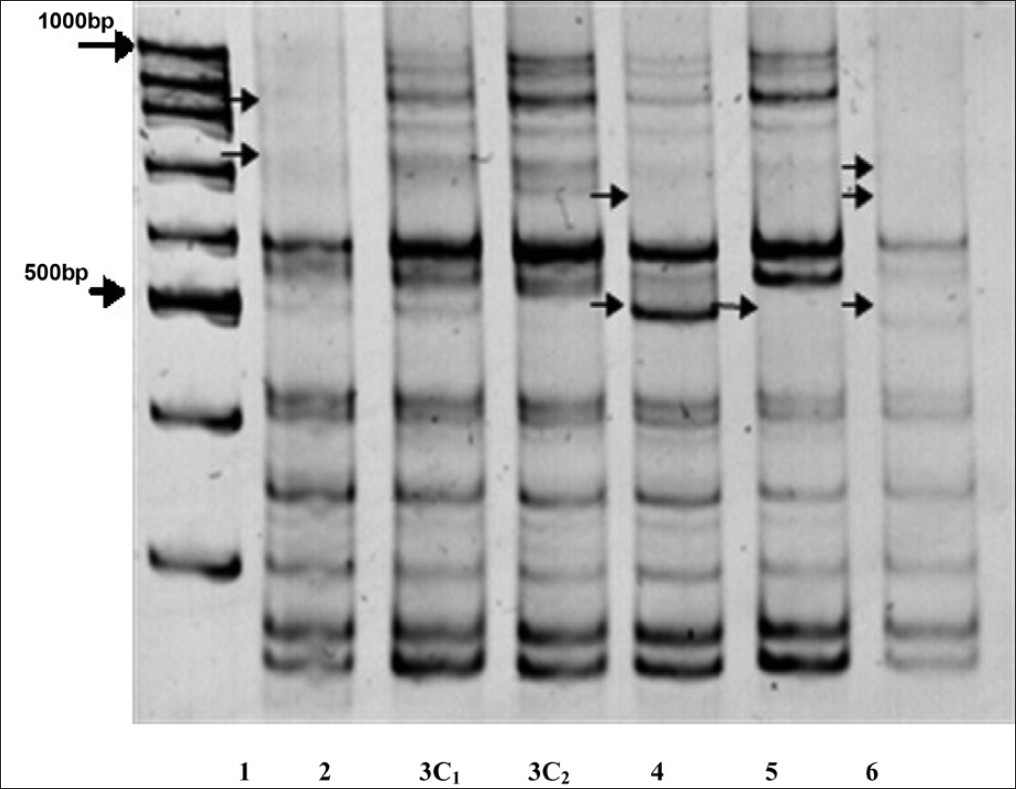  |
CD14 C-159T polymorphism and its association with chronic lung diseases: A pilot study on isocyanate exposed population of Central India |
p. 188 |
Protiti Bose, Rashmi Bathri, Sajal De, KK Maudar
DOI:10.4103/0971-6866.116124 PMID:24019621Context: CD14 functions as a multifunctional receptor for bacterial cell wall components including endotoxin and lipopolysaccharide and is likely to influence the cytokine profile and subsequent immunoglobulin E production in response to antigen/allergen contact in allergic phenotypes.
Aims: The present study was to investigate genetic polymorphism in CD14 gene - 159C/T, which may be one of the risk factor for increased prevalence of Chronic Lung Diseases in the Central India.
Settings and Design: Survivors of Methyl isocyanates toxicity in Bhopal still suffering from various respiratory ailments were examined.
Materials and Methods: Polymerase chain reaction-restriction fragment length polymorphism was performed to determine the polymorphism of C-159T.
Statistical analysis used: All analysis was done using SPSS software, version 11.5 (SPSS, Chicago, IL, USA).
Results: The genotype and allelic frequencies were in Hardy-Weinberg's equilibrium. Prevalence of CC, CT, and TT were 5.5%, 22.2% and 9.25% respectively in asthmatics; 16.6%, 20.3% and 5.5% respectively in chronic obstructive pulmonary disease (COPD) patients and 5.5%, 14.8% and 1.85 respectively among interstitial lung disorder (ILD) patients; whereas the control cohort with no methyl isocyanate exposure displayed (CC, CT, and TT) cytosine,thymine as 2%, 1.6% and 2% respectively. Increased risk of Asthma among those carrying TT genotype and T allele (odds ratio [OR] =2.61 and 2.02 respectively).
Conclusion: COPD risk significantly found among those with CC genotype and C allele (OR = 2.81 and 1.50 respectively), whereas ILD risk found significantly among CT genotype and C allele (OR = 1.75 and 1.40 respectively). Therefore, single nucleotide polymorphism (SNP) C-159T polymorphism in CD14 gene might be a risk factor for development of CLD in this population. |
| [ABSTRACT] [HTML Full text] [PDF] [Mobile Full text] [EPub] [Citations (1) ] [PubMed] [Sword Plugin for Repository]Beta |
|
|
|
|
|
|
Association between pediatric autoimmune neuropsychiatric disorders associated with streptococcal infections disease and tumor necrosis factor-α gene−308 g/a, −850 c/t polymorphisms in 4-12-year-old children in Adana/Turkey |
p. 196 |
H Umit Luleyap, Dilge Onatoglu, M Bertan Yilmaz, Davut Alptekin, Aysegul Y Tahiroglu, Salih Cetiner, Ayfer Pazarbasi, Ilker Unal, Ayse Avci, Gamze Comertpay
DOI:10.4103/0971-6866.116116 PMID:24019622Objectives: Pediatric Autoimmune Neuropsychiatric Disorders Associated with Streptococcal Infections (PANDAS) is a newly defined disease in neuropsychiatry and occurs with an autoimmune mechanism after Group A Beta Hemolytic Streptococcus (GABHS) infection. Tumor necrosis factor (TNF), encoded by TNF-α gene has an important role in the apoptotic mechanisms of autoimmune diseases. Recently, TNF-α polymorphisms and autoimmune/psychiatric disorders have been reported to be related. In this regard, we focused on to investigate a possible relation between the TNF-α gene promoter region−308 G/A and − 850 C/T polymorphisms and PANDAS.
Materials and Methods: In this study, ages of PANDAS patient and control groups were ranging from 4 years to 12-year-old. "Patient group" includes childhood onset PANDAS patients ( n = 42) and "control group" includes healthy children ( n = 58). Diagnoses have been carried out according to Diagnostic and Statistical Manual of Mental Disorder (DSM-IV) criteria with Affective Disorders and Schizophrenia-Present and Lifetime (KSAD-S-PL) and Children Yale-Brown Obsessive Compulsive Scale Moreover, PANDAS criteria established by the American National Psychiatry Institute have been employed for diagnoses. For identifying polymorphisms; Polymerase Chain Reaction, Restriction Fragment Length Polymorphism and Polyacrylamid Gel Electrophoresis were used.
Results and Discussion: For −308 polymorphism, 37 of 42 PANDAS patients' results and for −850 C/T polymorphism, 38 of 42 PANDAS patients' results were obtained. According to our statistical analysis there is a positive relationship between PANDAS patients for −308 G/A polymorphism but not for −850 C/T polymorphism. There is no positive relationship between −308 G/A polymorphism and antistrep-tolysin O (ASO) titers and no relationship between −850 C/T polymorphism and ASO titers. We found, however, positive relationship between genders of patients (boys) and the disease. According to our results, we propose that the AA polymorphism of −308 G/A polymorphism can be used as a molecular indicator for PANDAS. |
| [ABSTRACT] [HTML Full text] [PDF] [Mobile Full text] [EPub] [Citations (1) ] [PubMed] [Sword Plugin for Repository]Beta |
|
|
|
|
|
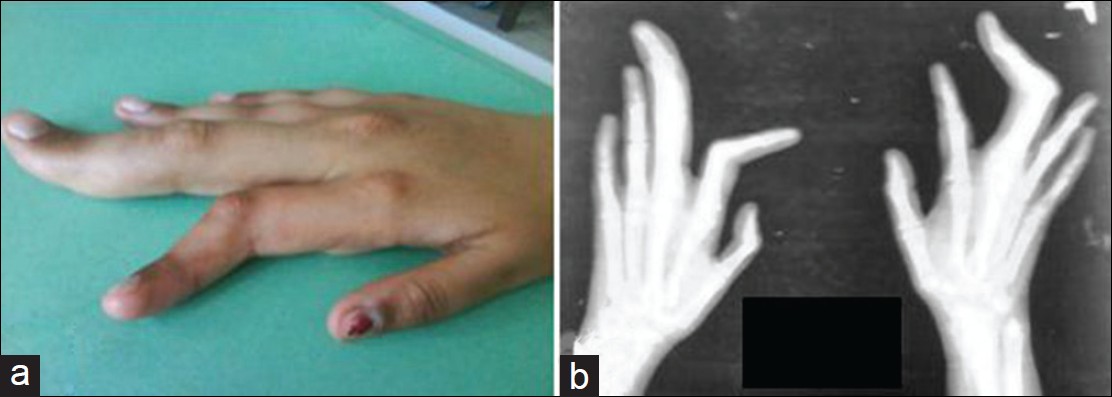  |
Proteus syndrome: Clinical profile of six patients and review of literature  |
p. 202 |
Suresh Kumar Angurana, Renu Suthar Angurana, Inusha Panigrahi, Ram Kumar Marwaha
DOI:10.4103/0971-6866.116117 PMID:24019623Objective: Proteus syndrome (PS) is characterized by patchy or segmental overgrowth and hyperplasia of multiple tissues and organs, along with susceptibility to development of tumors. Very few cases are reported in literature from developing countries. Due to certain overlapping features with other overgrowth syndromes, diagnosis is usually delayed. Our aim was to describe clinical profile of this rare condition in six patients.
Materials and Methods: Retrospective case sheet review of patients followed in a Pediatric Genetic and Metabolic clinic at a tertiary care institute of North India with a diagnosis of hemihypertrophy/overgrowth syndrome.
Results: Six cases presented with asymmetric overgrowth and peculiar features suggestive of PS were included in this study. Age at presentation was 2 months to 10 years; two were males and four were females. Hemihypertrophy was noticed in only one case at birth, and focal overgrowths in rest of other patients were seen later during childhood.
Conclusion: Due to certain overlapping features with other overgrowth syndromes, diagnosis of PS is usually delayed. Pediatricians are the first persons who come across such patients and they should be aware about this rare condition. |
| [ABSTRACT] [HTML Full text] [PDF] [Mobile Full text] [EPub] [PubMed] [Sword Plugin for Repository]Beta |
|
|
|
|
|
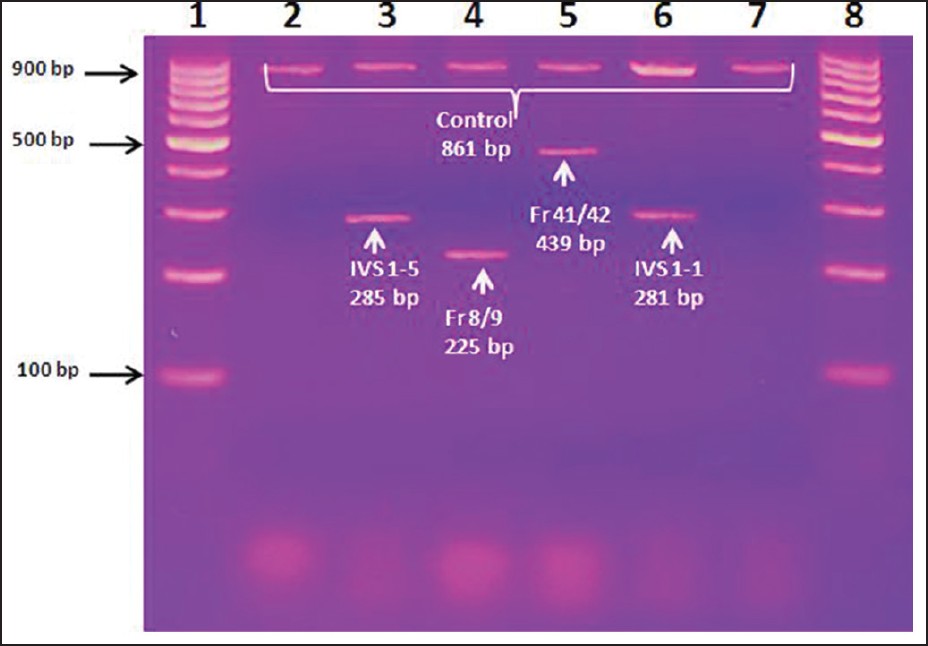  |
Unique pattern of mutations in β-thalassemia patients in Western Uttar Pradesh |
p. 207 |
Ajay F Christopher, Anita Kumari, Sunali Chaudhary, Sandhya Hora, Ziledar Ali, Satish C Agrawal
DOI:10.4103/0971-6866.116119 PMID:24019624Context: β-thalassemia is one of the most common heterogeneous inherited single gene disorders. The disease results from one or more of 380 different mutations in the β-globin gene. Uttar Pradesh (U.P.) is the most populous state of India, comprising various ethnic groups and Bareilly is one of the largest cities situated in Western U.P.
Aims: To examine the prevalence of five common β-thalassemian mutations: Intervening Sequence IVS 1-5 (c. 92 + 5 G > C), codon 8/9 (c. 27_28insG), codon 41/42 (c. 124_127delTTCT), IVS 1-1 (c. 92 + 1 G > T) and codon 26 G-A (c. 79G > A) in Western U.P.
Settings and Design: Patients attending camps organized by the Thalassemia Society, Bareilly were selected for the study.
Materials and Methods: A total of 48 blood samples were collected from the patients of transfusion dependent β-thalassemia from July 2011 to May 2012. All the samples were analyzed for five common mutations by using the Amplification Refractory Mutation System (ARMS)-hot start-polymerase chain reaction (PCR) technique.
Results: Among the five common mutations prevalent in India, we were able to detect all except codon 26 G-A (c. 79G > A), which is prevalent in northeast India. These four mutations accounted for 58% of the total number of our patients. The IVS 1-5 (G-C) was found to be the most common mutation with a frequency of 46% and the 2 nd most common mutation was Fr8/9 (+G) with a frequency of 21%. The frequency of other mutations was IVS1-1 (12%) and Cd 41/42 (4%).
Conclusion: This study provides evidence that the pattern of mutations in Western U.P. is different from the rest of India and even from the neighboring states (Delhi and Punjab). To the best of our knowledge, mutation Fr8/9, the 2 nd most common mutation in our study has never been reported to be so common from anywhere in India. Some mutations, which are prevalent in other regions are absent in our region (mutation for ε-globin). Hence, these findings can be called unique to Western U.P. |
| [ABSTRACT] [HTML Full text] [PDF] [Mobile Full text] [EPub] [PubMed] [Sword Plugin for Repository]Beta |
|
|
|
|
|
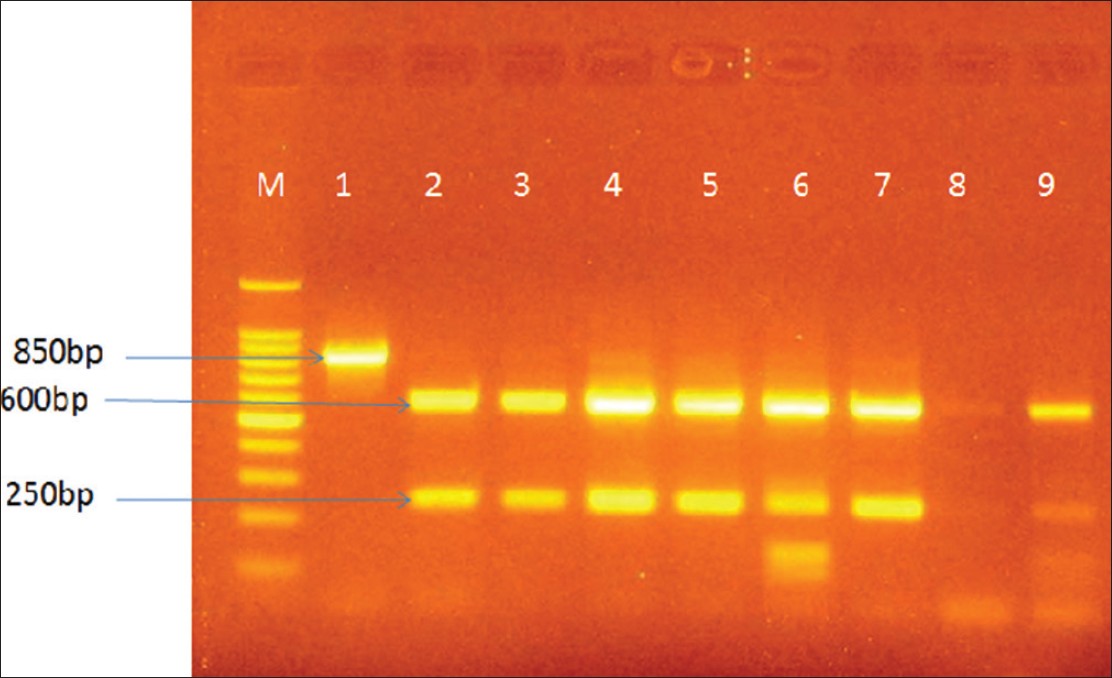  |
Angiotensin II type 1 receptor A1166C gene polymorphism and essential hypertension in Calabar and Uyo cities, Nigeria |
p. 213 |
Mary Esien Kooffreh, Chiaka Ijeoma Anumudu, Roseline Duke, Elza Cletus Okpako, P Lava Kumar
DOI:10.4103/0971-6866.116120 PMID:24019625Objectives: The angiotensin II protein is a vasoconstrictor that exerts most of its influence through the angiotensin II type 1 receptor (AT 1 R). Inconsistent association between the A1166C polymorphism of the AT 1 R gene and hypertension has been reported among various populations but not among the peoples of Calabar and Uyo. This study was designed to determine the frequency of the A1166C polymorphism of the AT 1 R gene and its association with hypertension in a sample population of Calabar and Uyo.
Materials and Methods: A population-based case control design consisting of total of 1224 participants, 612 each of patients and controls were randomly recruited from hypertension clinics and the general population. Genotyping of the A1166C allele of the AT 1 R gene to identify variants was performed using polymerase chain reaction and restriction enzyme digestion. Multiple regressions were applied to test whether the A1166 genotypes were predictors of hypertension.
Results: 99% of the study population had the wild type AA genotype, and 1% was AC heterozygous carriers of the A1166C polymorphism.
Conclusion: The A1166C polymorphism was not a predictor of hypertension in the sample population of Calabar and Uyo. |
| [ABSTRACT] [HTML Full text] [PDF] [Mobile Full text] [EPub] [PubMed] [Sword Plugin for Repository]Beta |
|
|
|
|
|
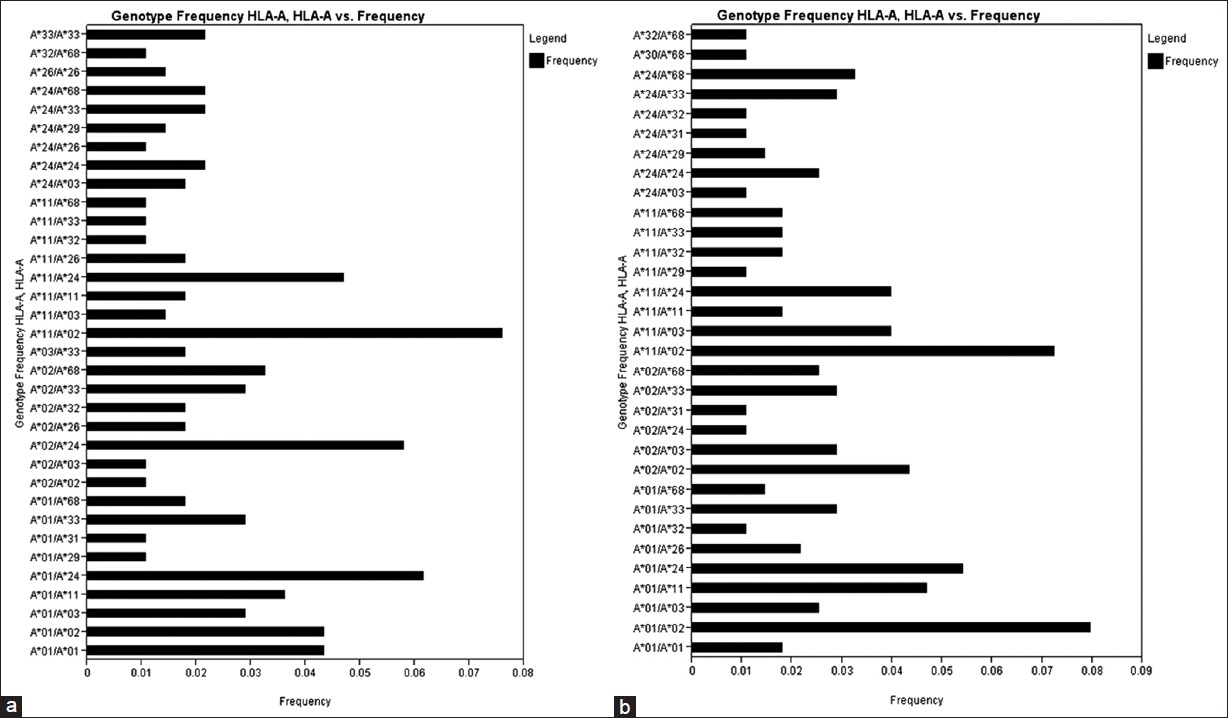  |
Human leukocyte antigen alleles, genotypes and haplotypes frequencies in renal transplant donors and recipients from West Central India |
p. 219 |
Jaina S Patel, Manisha M Patel, Prakash G Koringa, Tejas M Shah, Amrutlal K Patel, Ajai K Tripathi, Anila Mathew, Mohan M Rajapurkar, Chaitanya G Joshi
DOI:10.4103/0971-6866.116122 PMID:24019626Background: Human leukocyte antigen (HLA) is comprised of a highly polymorphic set of genes which determines the histocompatibility of organ transplantation. The present study was undertaken to identify HLA class I and class II allele, genotype and haplotype frequencies in renal transplant recipients and donors from West Central India.
Materials and Methods: HLA typing was carried out using Polymerase Chain Reaction-Sequence Specific Primer in 552 live related and unrelated renal transplant recipients and donors.
Results: The most frequent HLA class I and class II alleles and their frequencies in recipients were HLA-A*01 (0.1685) and A*02 (0.1649), HLA-B*35 (0.1322), and HLA-DR beta 1 (DRB 1)*15 (0.2192), whereas in donors, these were HLA-A*02 (0.1848) and A*01 (0.1667), HLA-B*35 (0.1359), and HLA-DRB1*15 (0.2409). The two-locus haplotype statistical analysis revealed HLA-A*02-B61 as the most common haplotype with the frequency of 0.0487 and 0.0510 in recipients and donors, respectively. Further, among the three locus haplotypes HLA-A*33-B*44-DRB1*07 and HLA-A*02-B*61-DRB1*15 were the most common haplotypes with frequencies 0.0362 and 0.0326, respectively in recipients and 0.0236 and 0.0323, respectively in donors. Genotype frequency revealed a high prevalence of genotype HLA-A*02/A*24 in recipients (0.058) compared to donors (0.0109) whereas low prevalence of HLA-A*01/A*02 in recipients (0.0435) than in donors (0.0797). The phylogenetic and principal component analysis of HLA allele and haplotype frequency distribution revealed genetic similarities of various ethnic groups. Further, case control analysis provides preliminary evidence of association of HLA-A genotype ( P < 0.05) with renal failure.
Conclusion: This study will be helpful in suitable donor search besides providing valuable information for population genetics and HLA disease association analysis. |
| [ABSTRACT] [HTML Full text] [PDF] [Mobile Full text] [EPub] [Citations (1) ] [PubMed] [Sword Plugin for Repository]Beta |
|
|
|
|
|
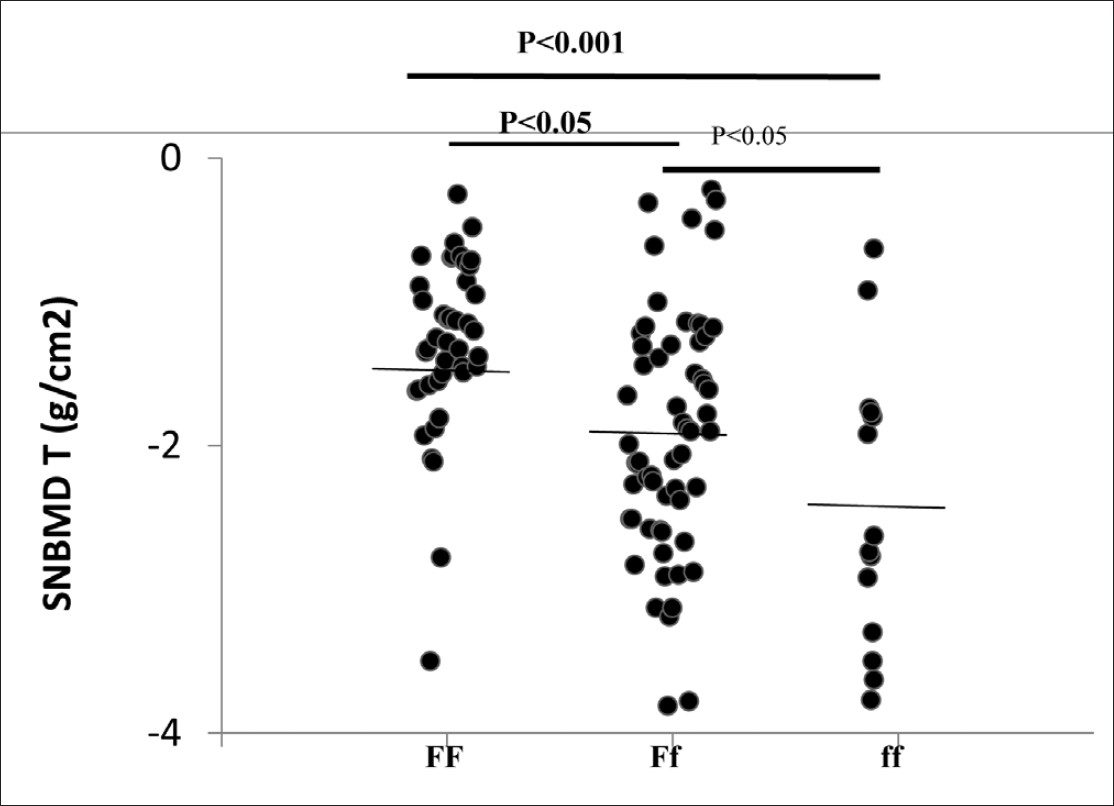  |
The effect of FokI vitamin D receptor polymorphism on bone mineral density in Jordanian perimenopausal women |
p. 233 |
Raed M Kanan
DOI:10.4103/0971-6866.116125 PMID:24019627Context: Osteoporosis is a polygenic, multifactorial disease that is characterized by demineralization of bone, and thus presented with decreasing bone mineral mass. Vitamin D receptor (VDR) gene polymorphisms in the 3'-end region (as determined by the enzymes BsmI and ApaI) have been inconsistently associated with bone mineral mass. Another important VDR start codon polymorphism (as determined by the enzyme FokI) has been found to be related to adult bone mineral density (BMD) in pre-and post-menopausal American women.
Aims: This study aims to investigate the prevalence of the FokI VDR gene polymorphism in Jordanian perimenopausal women and study its relationship with bone mineral density.
Materials and Methods: DNA was isolated from 90 controls (Mean age = 50.41 ± 1.29 y), and 120 patients with symptomatic vertebral fractures (Mean age = 49.14 ± 3.19 y). Restriction Fragment Length Polymorphism (RFLP) analysis of FokI was performed on DNA samples.
Statistical Analysis: Data was analyzed using SPSS v19 and Microsoft Excel 2007.
Results: The results showed that in controls, the FF (−0.70 ± 0.51) genotype is associated with high lumbar spine BMD Z-score as compared to Ff (−1.25 ± 0.26) and ff (−1.66 ± 0.47) genotypes (P = 0.0095). In patients, the ff genotype was associated with lower lumbar spine BMD in T-score (−2.31 ± 0.17) and Z-score (−1.56 ± 0.09) genotypes (P = 0.031). No significant association was seen in the femoral neck BMD.
Conclusion: FokI polymorphism may be associated with low BMD in our studied population; however, further studies including other polymorphisms and large sample number are needed. |
| [ABSTRACT] [HTML Full text] [PDF] [Mobile Full text] [EPub] [Citations (3) ] [PubMed] [Sword Plugin for Repository]Beta |
|
|
|
|
|
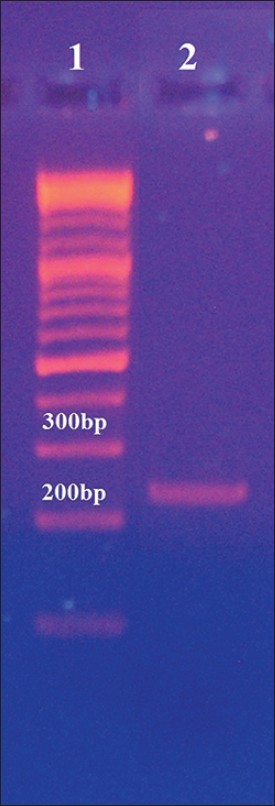  |
Association between PRO12ALA polymorphism of the PPAR-γ2 gene and type 2 diabetes mellitus in Iranian patients |
p. 239 |
Azadeh Motavallian, Sasan Andalib, Golnaz Vaseghi, Hamid Mirmohammad-Sadeghi, Masoud Amini
DOI:10.4103/0971-6866.116126 PMID:24019628Background: Peroxisome proliferator-activated receptor (PPARs) have been identified as ligand-activated transcription factors that belong to the nuclear receptor superfamily. It has been shown that an association exists between Proline 12 alanine (Pro12Ala) polymorphism of PPAR-GAMMA2 (PPAR-γ2) gene and increased risk of type 2 diabetes mellitus (T2DM) in different populations. Therefore, the present study was designed to investigate the association between Pro12Ala polymorphism of PPAR-γ2 gene and T2DM in an Iranian population.
Materials and Methods: Two hundred unrelated people, including 100 healthy controls and 100 diabetic patients were recruited diagnosed based on American Diabetes Association criteria. Blood samples were used for isolation of genomic deoxyribonucleic acid (DNA). Having extracted the genomic DNA from human blood leukocytes by means of High Pure polymerase chain reaction (PCR) Template preparation kit, we carried out polymerase chain reaction-restriction fragment length polymorphism (PCR-RFLP) on each blood sample. Then, Genomic DNA was digested by BstU-I restriction enzyme. Thereafter, restriction products were analyzed by means of Polyacrylamide gel electrophoresis and stained by Ethidium Bromide.
Results: We found that the frequency of Ala allele in healthy subjects was significantly higher than in diabetic subjects ( P = 0003). Moreover, the genotype frequency of Ala/Ala in healthy subjects was significantly higher than in diabetic subjects ( P < 0.001). However, the genotype frequency of Ala/Pro in diabetic subjects was significantly higher than in healthy subjects ( P < 0.001).
Conclusion: The present study suggests that polymorphism of PPAR-γ2 gene is associated with T2DM. Furthermore, Ala allele is significantly found in non-diabetic individual's Iranian population. |
| [ABSTRACT] [HTML Full text] [PDF] [Mobile Full text] [EPub] [Citations (1) ] [PubMed] [Sword Plugin for Repository]Beta |
|
|
|
|
|
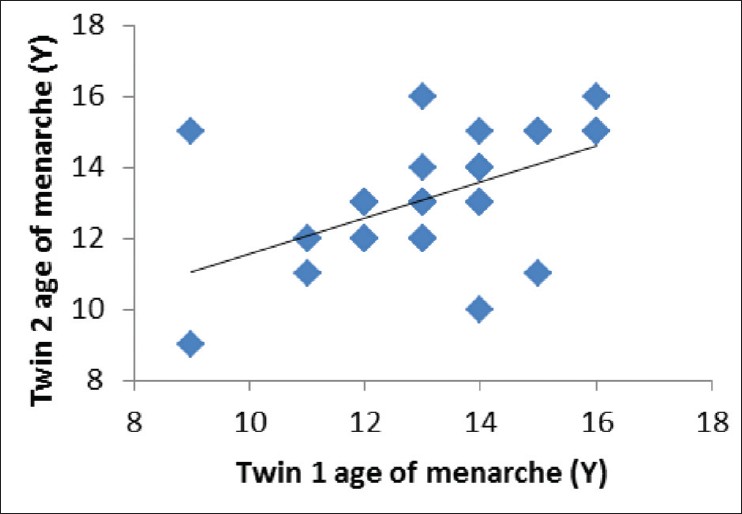  |
Genetic and environmental effects on age at menarche, and its relationship with reproductive health in twins |
p. 245 |
Shayesteh Jahanfar, Munn-Sann Lye, Isthrinayagy S Krishnarajah
DOI:10.4103/0971-6866.116127 PMID:24019629Introduction: Menarche or first menstrual period is a landmark in reproductive life span and it is the most prominent change of puberty. The timing of menarche can be under the influence of genes as well as individual environmental factors interacting with genetic factors.
Objective: Our study objectives were (a) to investigate the heritability of age of menarche in twins, (b) to obtain the association between age of menarche and childhood factors, and reproductive events/behavior, (c) to examine whether or not having a male co-twin affects early/late menarche.
Methodology: A group of female-female identical ( n = 108, 54 pairs), non-identical twins ( n = 68, 34 pairs) and 17 females from opposite-sex twin sets were identified from twin registries of Malaysia and Iran. Genetic analysis was performed via two methods of Falconers' formula and maximum likelihood.
Results: Heritability was found to be 66% using Falconers' formula and 15% using univariate twin analysis. Model analysis revealed that shared environmental factors have a major contribution in determining the age of menarche (82%) followed by non-shared environment (18%).
Discussion: Result of this study is consistent with that of the literature. Timing of menarche could be under the influence of shared and non-shared environmental effects. Hirsutism was found to have a higher frequency among subjects with late menarche. There was no significant difference in age of menarche between females of opposite-sex twins and females of same-sex twins.
Conclusion: It is concluded that twin models provide a powerful means of examining the total genetic contribution to age of menarche. Longitudinal studies of twins may clarify the type of environmental effects that determine the age of menarche. |
| [ABSTRACT] [HTML Full text] [PDF] [Mobile Full text] [EPub] [Citations (1) ] [PubMed] [Sword Plugin for Repository]Beta |
|
|
|
|
|
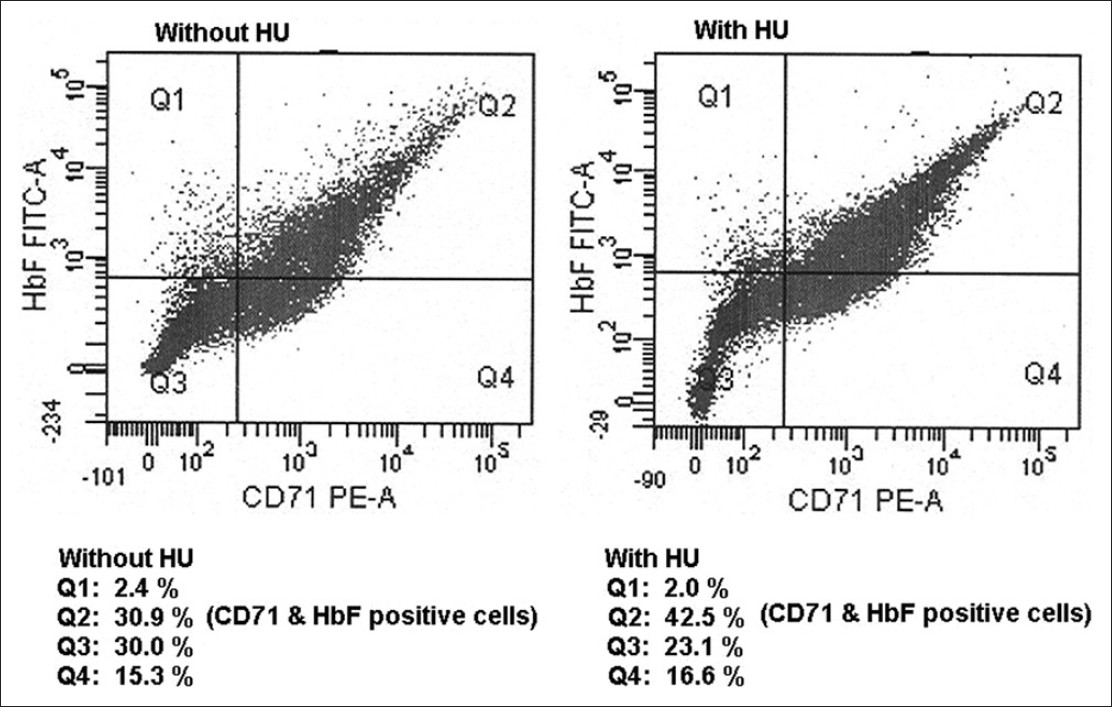  |
Comparison of in-vitro and in-vivo response to fetal hemoglobin production and γ-mRNA expression by hydroxyurea in Hemoglobinopathies |
p. 251 |
Khushnooma Italia, Farah Jijina, Rashid Merchant, Suchitra Swaminathan, Anita Nadkarni, Maya Gupta, Kanjaksha Ghosh, Roshan Colah
PMID:24019630Background: Hydroxyurea, which induces Fetal hemoglobin (HbF) synthesis, is the only drug widely used in different hemoglobinopathies; however, the response is very variable. We compared the efficacy of hydroxyurea in-vitro in erythroid cultures and in-vivo in the same patients with different hemoglobinopathies to induce HbF production and enhance γ-messenger RNA expression.
Materials and Methods: A total of 24-patients with different Hemoglobinopathies were given hydroxyurea and their response was studied in-vivo and in-vitro on mononuclear cells collected from them simultaneously.
Results: A total of 57.7% of patients (responders) showed no further crisis or transfusion requirements after hydroxyurea therapy with a mean increase in fetal cells (F-cells) of 63.8 ± 59.1% and γ-mRNA expression of 205.5 ± 120.8%. In-vitro results also showed a mean increase in F-cells of 27.2 ± 24.7% and γ-mRNA expression of 119.6% ± 65.4% among the treated cells. Nearly 19.0% of the partial-responders reduced their transfusion requirements by 50% with a mean increase in F-cells of 61.2 ± 25.0% and 28.4 ± 25.3% and γ-mRNA-expression of 21.0% ± 1.4% and 80.0% ± 14.1% in-vivo and in-vitro respectively. The non-responders (15.3%) showed no change in their clinical status and there was no significant increase in F-cells levels and γ-mRNA expression in-vivo or in-vitro.
Conclusion: Thus, this method may help to predict the in-vivo response to hydroxyurea therapy; however, a much larger study is required. |
| [ABSTRACT] [HTML Full text] [PDF] [Mobile Full text] [EPub] [PubMed] [Sword Plugin for Repository]Beta |
|
|
|
|
|
|
| CASE REPORTS |
 |
|
|
|
Early diagnosis of co-existent ß-thalassemia and alkaptonuria |
p. 259 |
Moushumi Lodh, Joshi A Kerketta
DOI:10.4103/0971-6866.116104 PMID:24019631Since the aggregate incidence of inborn errors of metabolism is relatively high, a high degree of suspicion is essential to correctly diagnose an inborn error of amino acid metabolism. We report a case of alkaptonuria an autosomal recessive disorder that occurs due to deficiency of homogentisic acid oxidasein a β-thalassemia infant presenting with reddish discoloration of nappies and clothes, breath holding spells, and microcytic hypochromic anemia. Born to consanguineous cousins, to our knowledge, the combination of β-thalassemia and alkaptonuria, which we have described in this baby, has not been reported earlier. |
| [ABSTRACT] [HTML Full text] [PDF] [Mobile Full text] [EPub] [PubMed] [Sword Plugin for Repository]Beta |
|
|
|
|
|
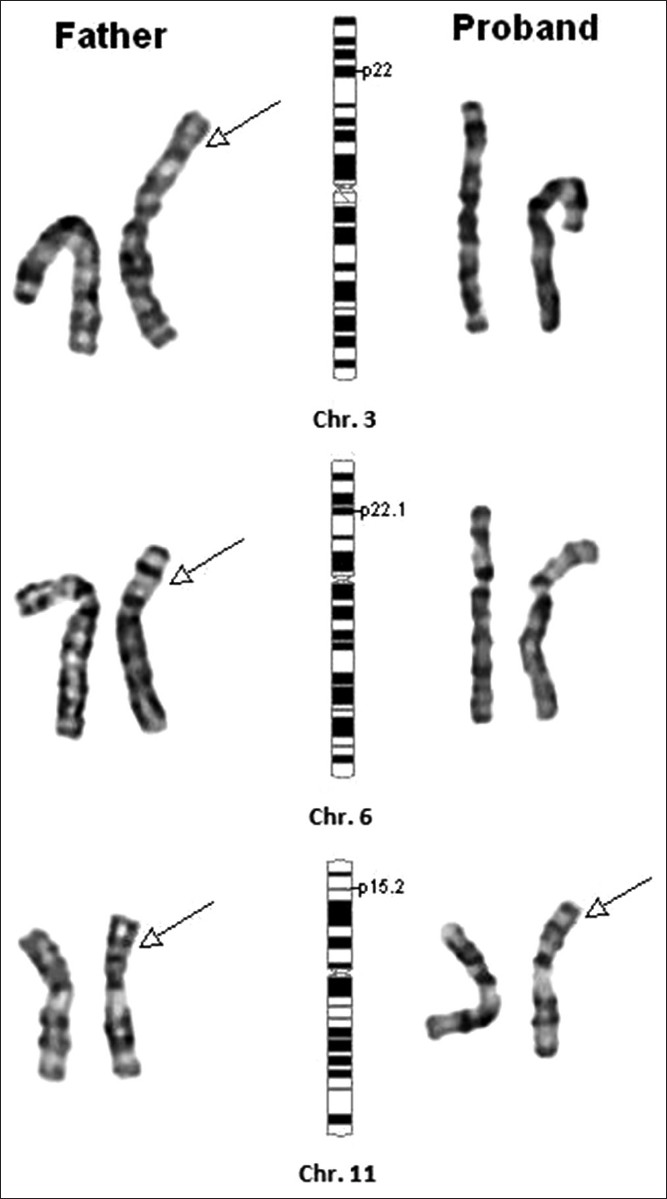  |
Derivative chromosome 11 in a child resulting from a complex rearrangement involving chromosomes 3, 6 and 11 in father: Significance of parental karyotyping |
p. 262 |
Prabhat Ranjan, Kundanbala Desai, Shailaja Gada Saxena
DOI:10.4103/0971-6866.116105 PMID:24019632The presence of derivative chromosome in a child with phenotypic features necessitates the need of parental karyotyping to ascertain the exact amount of loss or gain of the genetic material. The aim of this study was to emphasize the importance of parental karyotyping. Cytogenetic evaluation of the proband and his father were carried out at Laboratory. Cytogenetic analysis was performed on phytohemagglutinin stimulated cultures. The derivative chromosome 11 in proband was ascertained to have additional material from chromosome 6p arising from complex chromosomal rearrangement in the father. Karyotyping is the basic, cost-effective preliminary investigation in a child with mental subnormality or congenital anomalies. |
| [ABSTRACT] [HTML Full text] [PDF] [Mobile Full text] [EPub] [PubMed] [Sword Plugin for Repository]Beta |
|
|
|
|
|
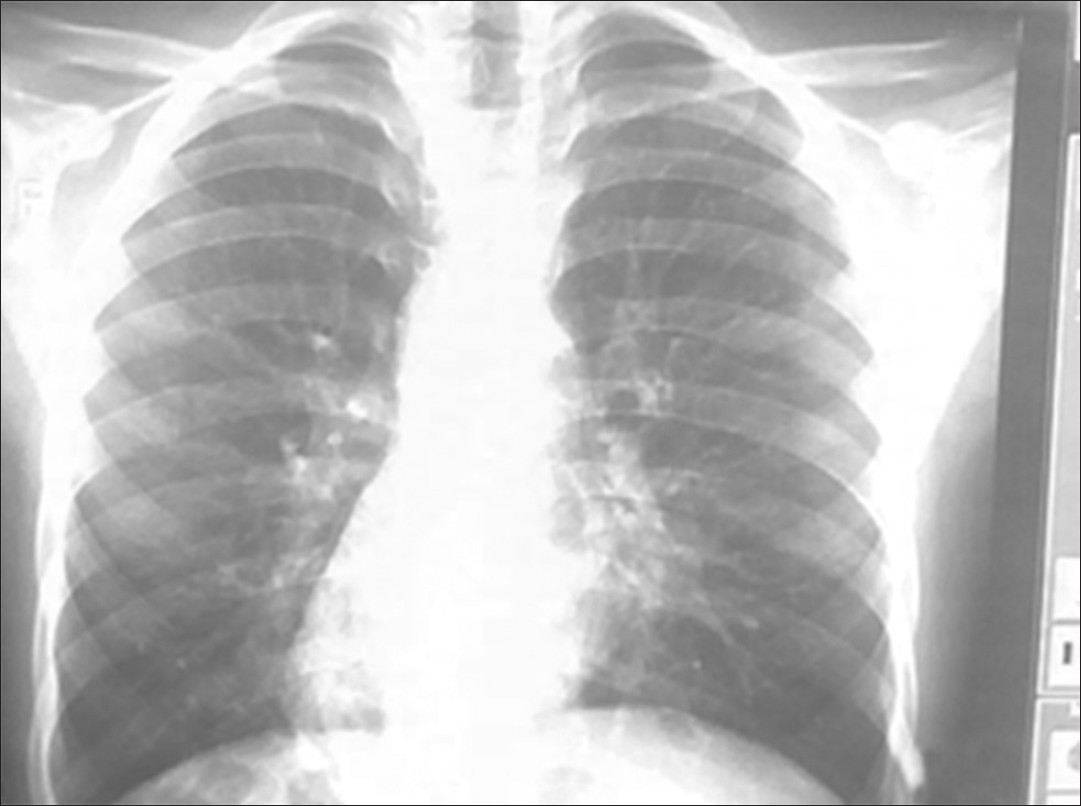  |
A case of Kartagener's syndrome: Importance of early diagnosis and treatment |
p. 266 |
Sanjay Gupta, Kumud K Handa, Ravi R Kasliwal, Pankaj Bajpai
DOI:10.4103/0971-6866.116107 PMID:24019633Kartagener's syndrome is a very rare congenital malformation comprising of a classic triad of sinusitis, situs inversus and bronchiectasis. Primary ciliary dyskinesia is a genetic disorder with manifestations present from early life and this distinguishes it from acquired mucociliary disorders. Approximately one half of patients with primary ciliary dyskinesia have situs inversus and, thus are having Kartagener syndrome. We present a case of 12 year old boy with sinusitis, situs inversus and bronchiectasis. The correct diagnosis of this rare congenital autosomal recessive disorder in early life is important in the overall prognosis of the syndrome, as many of the complications can be prevented if timely management is instituted, as was done in this in this case. |
| [ABSTRACT] [HTML Full text] [PDF] [Mobile Full text] [EPub] [PubMed] [Sword Plugin for Repository]Beta |
|
|
|
|
|
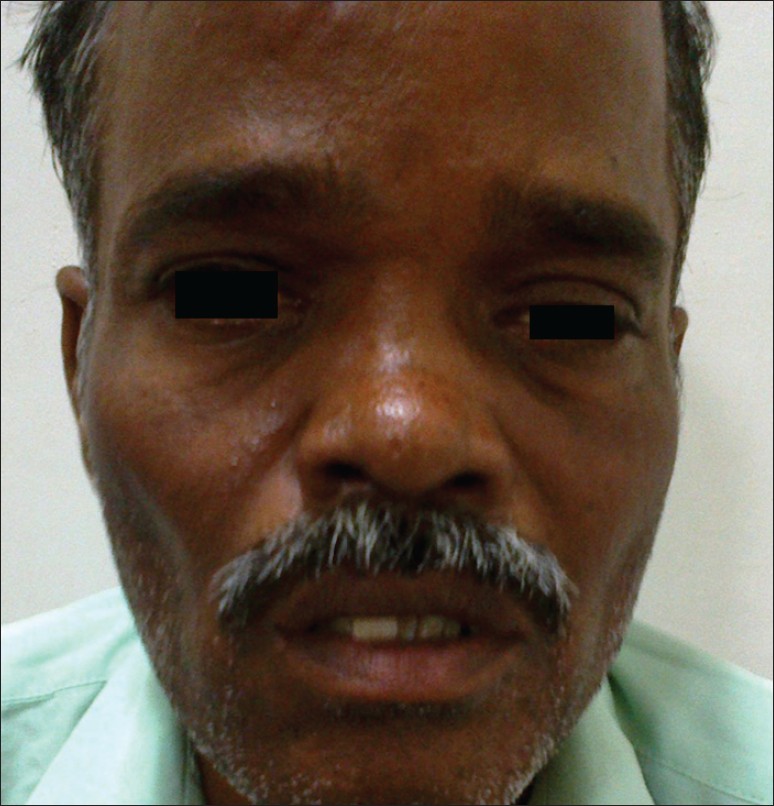  |
Sclerosterosis (Truswell-Hansen disease) |
p. 270 |
S Deepak Amalnath, M Vivekanandan
DOI:10.4103/0971-6866.116109 PMID:24019634Sclerosteosis or Truswell-Hansen disease is a rare autosomal recessive disorder characterized by dense bones, tall stature, and syndactyly. Most of the reports are from South Africa. Here we report the first such case from India. |
| [ABSTRACT] [HTML Full text] [PDF] [Mobile Full text] [EPub] [PubMed] [Sword Plugin for Repository]Beta |
|
|
|
|
|
|
| LETTERS TO THE EDITOR |
 |
|
|
|
Micro-RNAs in IVF outcome |
p. 273 |
Saeid Ghorbian, Ahmad Poursadegh Zonouzi
DOI:10.4103/0971-6866.116110 PMID:24019635 |
| [HTML Full text] [PDF] [Mobile Full text] [EPub] [PubMed] [Sword Plugin for Repository]Beta |
|
|
|
|
|
|
Large scale meta-analysis of genetic studies in ischemic stroke: Five genes involving 152,297 individuals |
p. 273 |
Khalil Hamzi, Bréhima Diakité, Amal Tazzite, Sellama Nadifi
DOI:10.4103/0971-6866.116112 PMID:24019636 |
| [HTML Full text] [PDF] [Mobile Full text] [EPub] [PubMed] [Sword Plugin for Repository]Beta |
|
|
|
|
|
|
Effect of the novel Moroccan BRCA1 and BRCA2 frameshift mutations |
p. 274 |
Amal Tazzite, Hassan Jouhadi, Khalil Hamzi, Abdellatif Benider, Sellama Nadifi
DOI:10.4103/0971-6866.116114 PMID:24019637 |
| [HTML Full text] [PDF] [Mobile Full text] [EPub] [PubMed] [Sword Plugin for Repository]Beta |
|
|
|
|
|






